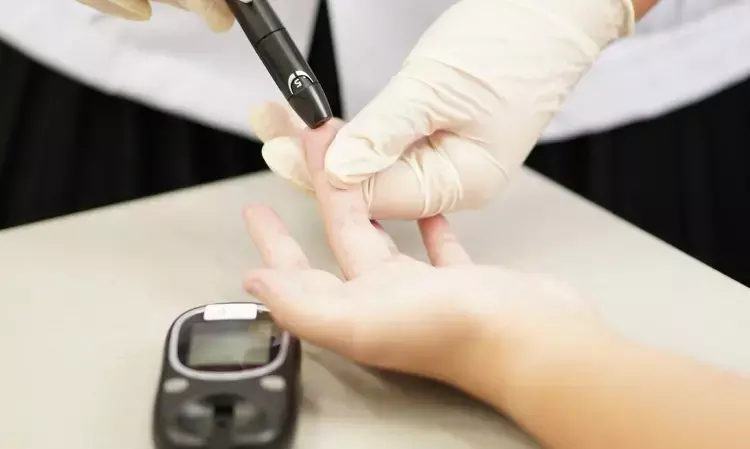- Home
- Medical news & Guidelines
- Anesthesiology
- Cardiology and CTVS
- Critical Care
- Dentistry
- Dermatology
- Diabetes and Endocrinology
- ENT
- Gastroenterology
- Medicine
- Nephrology
- Neurology
- Obstretics-Gynaecology
- Oncology
- Ophthalmology
- Orthopaedics
- Pediatrics-Neonatology
- Psychiatry
- Pulmonology
- Radiology
- Surgery
- Urology
- Laboratory Medicine
- Diet
- Nursing
- Paramedical
- Physiotherapy
- Health news
- Fact Check
- Bone Health Fact Check
- Brain Health Fact Check
- Cancer Related Fact Check
- Child Care Fact Check
- Dental and oral health fact check
- Diabetes and metabolic health fact check
- Diet and Nutrition Fact Check
- Eye and ENT Care Fact Check
- Fitness fact check
- Gut health fact check
- Heart health fact check
- Kidney health fact check
- Medical education fact check
- Men's health fact check
- Respiratory fact check
- Skin and hair care fact check
- Vaccine and Immunization fact check
- Women's health fact check
- AYUSH
- State News
- Andaman and Nicobar Islands
- Andhra Pradesh
- Arunachal Pradesh
- Assam
- Bihar
- Chandigarh
- Chattisgarh
- Dadra and Nagar Haveli
- Daman and Diu
- Delhi
- Goa
- Gujarat
- Haryana
- Himachal Pradesh
- Jammu & Kashmir
- Jharkhand
- Karnataka
- Kerala
- Ladakh
- Lakshadweep
- Madhya Pradesh
- Maharashtra
- Manipur
- Meghalaya
- Mizoram
- Nagaland
- Odisha
- Puducherry
- Punjab
- Rajasthan
- Sikkim
- Tamil Nadu
- Telangana
- Tripura
- Uttar Pradesh
- Uttrakhand
- West Bengal
- Medical Education
- Industry
High 1-h glucose with obesity marker of prediabetes and CV risk among young adults

High 1-h glucose in youths with obesity is a marker of prediabetes and cardiovascular risk suggests a new study published in the Journal of Endocrinological Investigation
Testing 1-h glucose (1HG) concentration during oral glucose tolerance test is cost-effective to identify individuals at risk of incident type 2 diabetes. Aim of the study was to define 1HG cutoffs diagnostic of incident impaired glucose tolerance (IGT) in youths with obesity, and to evaluate prevalence and association of cutoffs identified in the cohort and from the literature (133 and 155 mg/dl) to cardiovascular disease (CVD) in a population of youths with obesity.
This is a longitudinal study of 154 youths to identify 1HG cutoffs, and cross-sectional study of 2295 youths to estimate prevalence of high 1HG and association to CVD. Receiver-operating characteristic curves (ROC) were used to establish 1HG cutoffs, and univariate regression analyses to test association of 1HG to blood pressure, lipids and aminotransferases.
Results:
ROC analysis identified the 1HG cutoff of 159 mg/dl as having diagnostic accuracy of IGT with area under the ROC 0.82 (95% CI 0.66-0.98), sensitivity 0.86% and specificity 0.79%. In the cross-sectional population, prevalence of high 1HG was 36% and 15% for 133 and 155 mg/dl cutoffs, respectively, and 17% for the 159 mg/dl value. All the examined cutoffs were significantly associated with worse lipid profile, liver function test, reduced insulin sensitivity, secretion and disposition index.
High 1HG is marker of persistent IGT and increased risk of metabolic abnormalities in youths. The 155 mg/dl cutoff is a convenient estimate in young people but longitudinal studies with retinopathy and overt diabetes as end points are advised to verify the 1HG cutoff with the best diagnostic accuracy.
Reference:
Ravà L, Fintini D, Mariani M, Deodati A, Inzaghi E, Pedicelli S, Bizzarri C, Cappa M, Cianfarani S, Manco M. High 1-h glucose in youths with obesity as marker of prediabetes and cardiovascular risk. J Endocrinol Invest. 2023 May 19. doi: 10.1007/s40618-023-02111-6. Epub ahead of print. PMID: 37204691.
Keywords:
Ravà L, Fintini D, Mariani M, Deodati A, Inzaghi E, Pedicelli S, Bizzarri C, Cappa M, Cianfarani S, Manco M, Journal of Endocrinological Investigation, 1-h glucose; Insulin secretion; Insulin sensitivity; Oral glucose tolerance test; Prediabetes.
Dr. Shravani Dali has completed her BDS from Pravara institute of medical sciences, loni. Following which she extensively worked in the healthcare sector for 2+ years. She has been actively involved in writing blogs in field of health and wellness. Currently she is pursuing her Masters of public health-health administration from Tata institute of social sciences. She can be contacted at editorial@medicaldialogues.in.
Dr Kamal Kant Kohli-MBBS, DTCD- a chest specialist with more than 30 years of practice and a flair for writing clinical articles, Dr Kamal Kant Kohli joined Medical Dialogues as a Chief Editor of Medical News. Besides writing articles, as an editor, he proofreads and verifies all the medical content published on Medical Dialogues including those coming from journals, studies,medical conferences,guidelines etc. Email: drkohli@medicaldialogues.in. Contact no. 011-43720751


